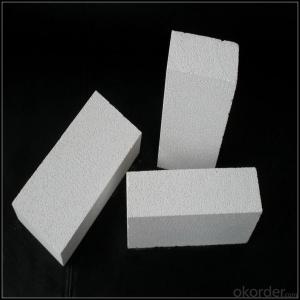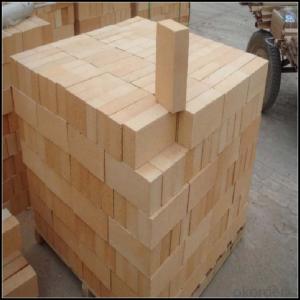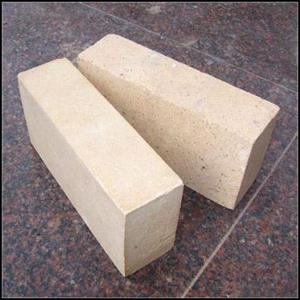Refractory Brick for Furnace Lining/High Alumina Brick
- Loading Port:
- China main port
- Payment Terms:
- TT OR LC
- Min Order Qty:
- 5 m.t
- Supply Capability:
- 800 m.t/month
OKorder Service Pledge
OKorder Financial Service
You Might Also Like
Refractory Brick
CMAX firebricks are classified under temperature between 1300℃ to 1700℃, manufactured from high purity alumina clay by mixing, press-forming, drying, sintering and machining. Bricks contain carefully-graded organic fillers which are burned out during sintering to give a uniform controllable pore structure. This technique makes product feature low thermal conductivity and excellent heat insulation
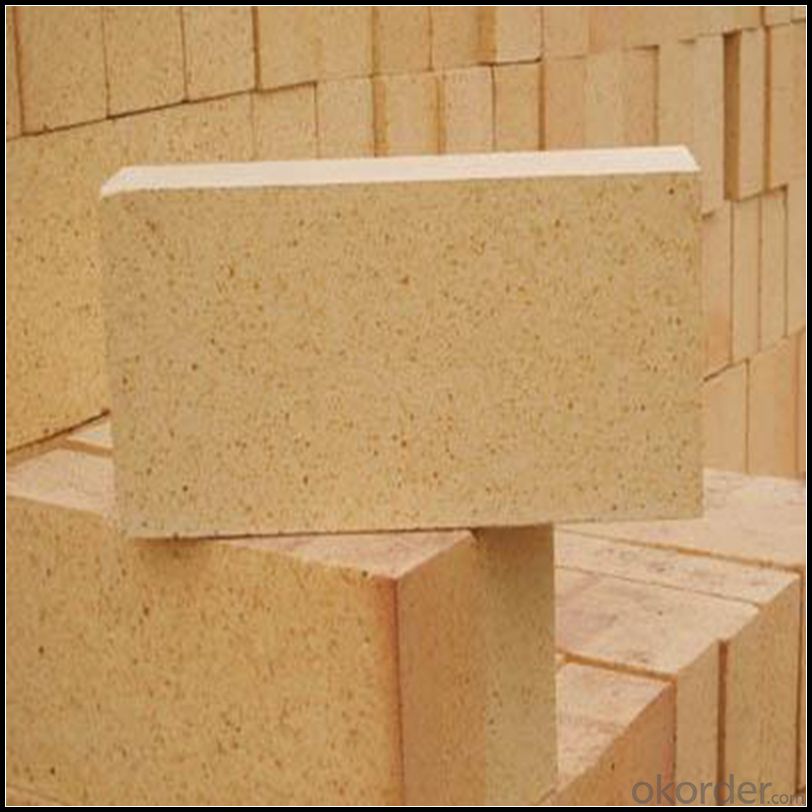
Features
1.Dense crystal structure.
2.High bulk density.
3.High mechanical strength at normal and high temperature.
4.Good thermal shock resistance.
4.Low creep and low permanent liner change rate.
5.High performance of chemical stability and alkaline medium erosion resistance.
Application
1.Building material industry,kiln,heating equipment and the inwall of high—temperature pipe line
2.Chemical industrial high temperature of reaction equipment inwall
3.Power plant ,gas turbine engine and heat insulation of unclear power
4.The fire proof of high—rise building
5.Furnace door of kiln
6.High-temperature filter material
Data Sheet
Classification Temperature (℉/℃) | 3000/1650 |
Bulk Density (g/cm3 ) | ≤1.0 |
Thermal Conductivity | |
800℃, W/m.K | ≤0.39 |
1000℃, W/m.K | ≤0.43 |
1200℃, W/m.K | ≤0.48 |
Reheating Linear Change (%) | 1550℃×12h |
≤0.9 | |
Chemical Composition (%) | |
Al2O3 | ≥75 |
Fe2O3 | ≤0.5 |
Packaging & Shipping
Packaging Details:Be packed in fumigated wooden pallets
Delivery Detail: 30 days after order

Our Services
Optimum solution and product supply of refractories for high temperature industries, such as iron steel, non-ferrous, petrochemical and building materials.
Engineering design, contract and consult for refractories, and civil architecture design.
Research, development, manufacture and sale of superhard materials.
R&D, manufacture and sale of special packing materials for export.
Inspection, supervision and arbitration of refractories.
Consultation and services in refractories information.
Training and cultivation of high-level talents in refractories profession
Sales Network

Company Information
CNBM (China National Building Material) Group is the largest comprehensive building materials group in China that in integrate scientific research, manufacturing and logistics into one entity. The largest building materials and equipment specialists in China. Upon State Council approval, today CNBM owned more than 300 subordinate manufacturing factories and servicing companies. There are 6 fully owned public listed companies and 11 partially owned with substantial shares public listed companies. In many of these fields, CNBM is playing the leading role in the building industry in the country.
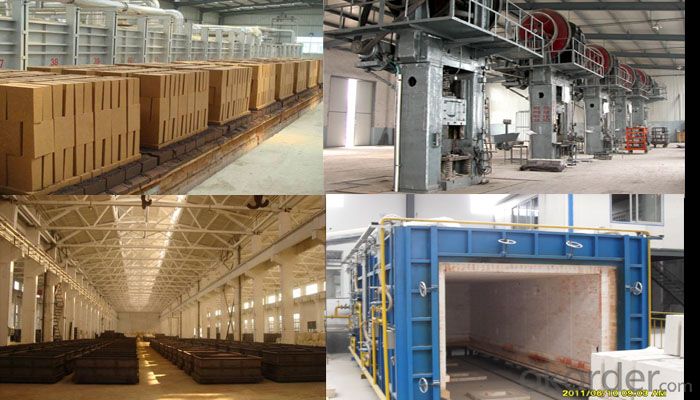
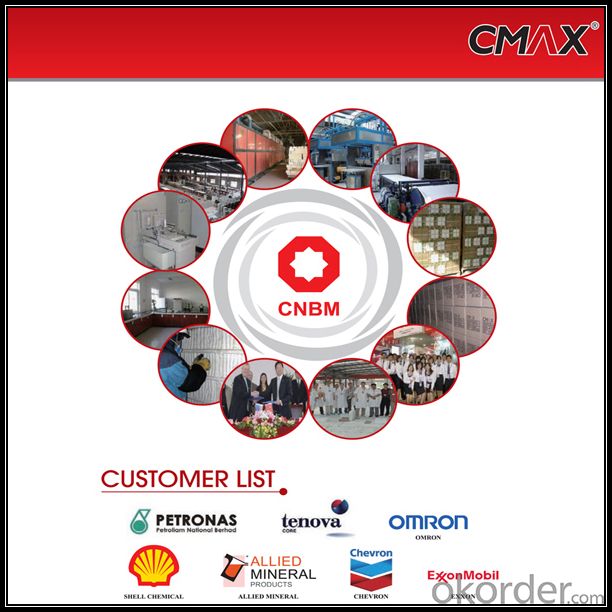
FAQ
1. Which products do you have?
We have all kinds of refractory brick, castable, mortar, cement, ceramic fiber products, etc.
Or you could browse our products to choose what you need.
2. Can you give me a brief introduction of the application of your products?
We are mainly specializing in the refractory materials in iron and steel, cement, glass, ceramics, petrochemical, electric power Industry, etc.
3. If I need your offer, what information do you need?
In order to choose suitable products, it will be appreciated to provide us the information, such us specification, technical data, order quantity, products application etc. If any question, please contact us freely.
- Q:How do insulating fire bricks compare to ceramic fiber insulation?
- Insulating fire bricks and ceramic fiber insulation have their own advantages and differences. Insulating fire bricks offer higher thermal conductivity and are more resistant to mechanical stress, making them suitable for applications where structural strength is required. On the other hand, ceramic fiber insulation provides excellent thermal insulation properties, is lightweight, and has superior resistance to thermal shock. The choice between the two ultimately depends on the specific requirements of the application.
- Q:Can insulating fire bricks be used in the construction of hearths?
- Indeed, hearths can be constructed using insulating fire bricks. These bricks are specifically engineered to endure extreme temperatures, rendering them a superb selection for hearth construction. With their low thermal conductivity, they effectively retain heat and hinder the transmission of heat to nearby surroundings. Consequently, they are perfect for establishing a well-insulated and efficient hearth. Furthermore, their lightweight and manageable nature make them highly convenient for construction tasks. All in all, insulating fire bricks prove to be a dependable and pragmatic choice for the development of hearths.
- Q:Do insulating fire bricks emit any harmful gases when heated?
- No, insulating fire bricks do not emit any harmful gases when heated. They are specifically designed to have excellent thermal insulation properties without releasing any harmful emissions.
- Q:Can insulating fire bricks be used in the construction of industrial dryers?
- Yes, insulating fire bricks can be used in the construction of industrial dryers. Insulating fire bricks are specifically designed to have low thermal conductivity, which means they are able to retain heat and prevent heat loss. This makes them an excellent choice for applications that require high temperatures, such as industrial dryers. Insulating fire bricks are made from lightweight materials such as clay, silica, and alumina, and are capable of withstanding temperatures of up to 3000°F (1650°C). They have excellent insulation properties, which help to reduce energy consumption and improve the overall efficiency of the industrial dryer. Additionally, insulating fire bricks are resistant to thermal shock, meaning they can withstand rapid temperature changes without cracking or breaking. This is particularly important in industrial dryer applications, where temperatures can fluctuate quickly. Overall, insulating fire bricks are a suitable choice for the construction of industrial dryers due to their low thermal conductivity, high temperature resistance, and ability to withstand thermal shock.
- Q:Can insulating fire bricks be used in incinerators?
- Yes, insulating fire bricks can be used in incinerators. Insulating fire bricks are specially designed to provide excellent thermal insulation, making them ideal for applications where high temperatures need to be maintained. In incinerators, which operate at extremely high temperatures, insulating fire bricks can help to reduce heat loss and improve the overall energy efficiency of the system. Additionally, these bricks have good resistance to thermal shock, which is crucial in incinerators where rapid temperature changes occur. Therefore, using insulating fire bricks in incinerators can help to enhance their performance and longevity.
- Q:Can insulating fire bricks be used in the construction of lime calciners?
- Indeed, the utilization of insulating fire bricks is feasible when constructing lime calciners. Lime calciners necessitate elevated temperatures for lime production, and insulating fire bricks are specifically engineered to endure and preserve heat. These bricks possess a reduced thermal conductivity, which effectively insulates the calciner and impedes heat dissipation. Furthermore, insulating fire bricks are lightweight, facilitating their handling and installation during the lime calciners' construction process.
- Q:Are insulating fire bricks resistant to flame spread?
- Insulating fire bricks exhibit exceptional resistance against flame propagation. Crafted with utmost precision, these bricks are tailored to endure extreme temperatures while effectively trapping and insulating heat. Constructed from refractory materials with minimal thermal conductivity, they possess remarkable capabilities in impeding heat transfer and thwarting the spread of flames. Widely employed in kilns, furnaces, and fireplaces, where maintaining and managing high temperatures is of paramount importance, these bricks' flame-resistant properties render them an unwavering and secure choice for such environments.
- Q:How do insulating fire bricks compare to other insulation materials?
- Insulating fire bricks are superior to other insulation materials in terms of their high heat resistance, durability, and ability to withstand extreme temperatures. They offer excellent thermal insulation properties, low thermal conductivity, and are capable of retaining heat for prolonged periods. Compared to traditional insulation materials like fiberglass and mineral wool, insulating fire bricks provide superior insulation performance and are more suitable for applications requiring high-temperature resistance, such as furnaces, kilns, and industrial ovens.
- Q:Can insulating fire bricks be used in ladles?
- Yes, insulating fire bricks can be used in ladles.
- Q:Can insulating fire bricks be used in wood-fired kilns?
- Yes, insulating fire bricks can be used in wood-fired kilns. These bricks are designed to withstand high temperatures and provide excellent insulation, making them ideal for wood-fired kilns. They help to retain heat and distribute it evenly throughout the kiln, ensuring efficient and consistent firing of the wood. Additionally, insulating fire bricks are lightweight, which can aid in the construction and maintenance of the kiln. Overall, using insulating fire bricks in wood-fired kilns can enhance their performance and efficiency.
1. Manufacturer Overview |
|
|---|---|
| Location | |
| Year Established | |
| Annual Output Value | |
| Main Markets | |
| Company Certifications | |
2. Manufacturer Certificates |
|
|---|---|
| a) Certification Name | |
| Range | |
| Reference | |
| Validity Period | |
3. Manufacturer Capability |
|
|---|---|
| a)Trade Capacity | |
| Nearest Port | |
| Export Percentage | |
| No.of Employees in Trade Department | |
| Language Spoken: | |
| b)Factory Information | |
| Factory Size: | |
| No. of Production Lines | |
| Contract Manufacturing | |
| Product Price Range | |
Send your message to us
Refractory Brick for Furnace Lining/High Alumina Brick
- Loading Port:
- China main port
- Payment Terms:
- TT OR LC
- Min Order Qty:
- 5 m.t
- Supply Capability:
- 800 m.t/month
OKorder Service Pledge
OKorder Financial Service
Similar products
New products
Hot products
Related keywords
